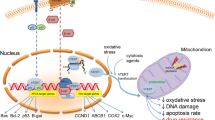Abstract
Telomeres are the specialized ends of eukaryotic chromosomes, thought to have many functions, most importantly serving as a clock signaling entry into cellular senescence. These structures are maintained by the reverse transcriptase telomerase, a peculiar enzyme in both structure, since it contains its own template RNA and function, since it is inactivated in most normal tissues but activated in the vast majority of malignant tumors. These features have made telomerase a subject of intense investigation, both to understand its cellular role and regulation and to exploit its activation in cancer to develop drugs or diagnostic methods based on telomerase. This work gathers all the information currently available in the biological and clinical fields of telomerase research.
Similar content being viewed by others
References
Blackburn EH; Structure and function of telomeres. Nature 350:569–572, 1991.
Kipling D. (ed): The telomere. Oxford University Press, Oxford, 1995.
Griffith JK, Comeau L, Rosenfield S, et al; Mammalian telomeres end in a large duplex loop. Cell 97:503–514, 1999.
Jun-Ping Liu; Studies of the molecular mechanisms in the regulation of telomerase activity. FASEB J 13:2091–2104, 1999.
Blackburn EH; Telomerases. Annu Rev Biochemistry 61:113–129, 1992.
Bhattacharyya A, Blackburn EH; A functional telomerase RNA swap in vivo reveals the importance of nontemplate RNA domains. Proc Natl Acad Sci USA 94:2823–2827, 1997.
Beattie TL, Zhou W, Robinson MO, et al; Reconstitution of human telomerase activity in vitro. Current Biology 8:177–180, 1998.
Kilian A, Bowtell DD, Abud HE, et al; Isolation of a candidate human telomerase catalytic subunit gene, which reveals complex splicing patterns in different cell types. Human Mol Genetic 6:2011–2019, 1997.
Biessmann H, Walter MF, Mason JM; Drosophila telomere elongation. Ciba Fndn Symp 211:53–70, 1997.
Zakian VA; Structure, function and replication of Saccharomyces cerevisiae telomeres. Annu Rev Genet 30:141–172, 1996.
Wang J, Xie LY, Allan S, et al; Myc activates telomerase. Genes Dev 12:1769–1774, 1998.
Kyo S, Takakura M, Kanaya T, et al; Estrogen activates telomerase. Cancer Res 59:5917–5921, 1999.
Li H, Cao Y, Berndt MC, et al; Molecular interactions between telomerase and the tumor suppressor protein p53 in vitro. Oncogene 18:6785–6794, 1999.
Van Steensel B, De Lange T; Control of telomere length by the human telomeric protein TRF1. Nature 385:740–743, 1997.
Smith S, Giriat I, Schmitt A, et al; Tankyrase, a poly(ADPribose) polymerase at human telomeres. Science 282:1484–487, 1998.
Wynford-Thomas D; p53: Guardian of cellular senescence. J Pathol 180:118–121, 1996.
Li H, Zhao LL., Funder JW, Liu JP; Protein phosphatase 2A inhibits nuclear telomerase activity in human breast cancer cells. J Biol Chem 272:16729–16732, 1997.
Li H, Zhao LL, Yang Z, et al; Telomerase is controlled by protein kinase Calpha in human breast cancer cells. J Biol Chem 273:33436–33442, 1998.
Bickenbach JR, Vornwald D, Bachor C, et al; Telomerase is not an epidermal stem cell marker and is downregulated by calcium. J Invest Dermatol 111:1045–1052, 1998.
Martens UM, Zijlmans JM, Poon SS, et al; Short telomeres on human chromosome 17p. Nature Genet 18:76–80, 1998.
Vaziri H, Schachter F, Uchida I, et al; Loss of telomeric DNA during aging of normal and trisomy 21 human lymphocytes. Am J Human Genet 52:661–667, 1993.
Hahn WC, Counter CM, Lundberg AS, et al; Creation of human tumour cells with defined genetic elements. Nature 400:464–468, 1999.
McKenzie KE, Umbricht CB, Sukumar S; Applications of telomerase research in the fight against cancer. Mol Med Today 5:114–122, 1999.
Davis AJ, Siu LL; Telomerase: therapeutic potential in cancer. Cancer Invest 18:269–277, 2000.
Shay JW, Wright WE; Telomerase activity in human cancer. Curr Opin Oncol 8:66–71, 1996.
Lichtsteiner SP, Lebkowski JS, Vasserot AP; Telomerase: A target for anticancer therapy. Ann NY Acad Sci 886:1–11, 1999.
Minev B, Hipp J, Firat H, et al; Cytotoxic T cell immunity against telomerase reverse transcriptase in humans. Proc Natl Acad Sci 97:4796–4801, 2000.
Hahn WC, Stewart WC, Brooks MW, et al.; Inhibition of telomerase limits the growth of human cancer cells. Nature Med 5:1164–1170, 1999
Duncan VE, Ajmani PS, Hughes JA; Cellular delivery is a major obstacle for oligodeoxynucleotide inhibition of telomerase activity. Anticancer Res 18:4105–4108, 1998.
Sawant SG, Gregoire V, Dhar S, et al; Telomerase activity as a measure for monitoring radiocurability of tumor cells. FASEB J 13:1047–1054, 1999.
Greider CW; Telomere length regulation. Annu Rev Biochem 65:337–365, 1996.
Harley CB, Futcher AB, Greider CW; Telomeres shorten during aging of human fibroblasts. Nature 345:458–460, 1990.
Author information
Authors and Affiliations
Corresponding author
Rights and permissions
About this article
Cite this article
Chatziantoniou, V.D. Telomerase: Biological function and potential role in cancer management. Pathol. Oncol. Res. 7, 161–170 (2001). https://doi.org/10.1007/BF03032344
Received:
Accepted:
Issue Date:
DOI: https://doi.org/10.1007/BF03032344




